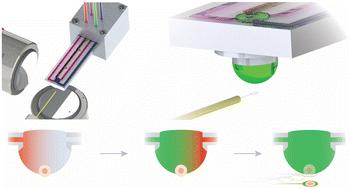Our official English website, www.x-mol.net, welcomes your
feedback! (Note: you will need to create a separate account there.)
A microfluidic hanging droplet as a programmable platform for mammalian egg vitrification
Lab on a Chip ( IF 6.1 ) Pub Date : 2024-10-02 , DOI: 10.1039/d4lc00428k Haidong Feng, Georgios Katsikis, India D. Napier, Gong Du, Josh Lim, Joseph O. Doyle, Scott R. Manalis, Linda G. Griffith
Lab on a Chip ( IF 6.1 ) Pub Date : 2024-10-02 , DOI: 10.1039/d4lc00428k Haidong Feng, Georgios Katsikis, India D. Napier, Gong Du, Josh Lim, Joseph O. Doyle, Scott R. Manalis, Linda G. Griffith

|
Egg (oocyte) vitrification is the dominant method for preserving fertility for women of reproductive age. However, the method is typically performed by hand, requiring precise (∼0.1 to 10 μL) and time-sensitive (∼1 s) liquid exchange of cryoprotectants (CPA) around eggs as well as fine handling of eggs (∼100 μm) for immersion into liquid nitrogen (LN2). Here, we developed a microfluidic platform for programmable vitrification. Our platform is based on a millimeter-sized hanging droplet inside which a given egg is suspended and subjected to liquid exchanges within seconds. After programmable exposures to CPA, the egg is extracted from the liquid–air interface of the droplet using a motorized fine-tip instrument and immersed into LN2 for vitrification. To benchmark our platform with the manual method, we vitrified over a hundred mouse eggs and found comparable percentages (∼95%) for post-vitrification survivability. In addition, our platform performs real-time microscopy of the egg thereby enabling future studies where its morphology may be linked to functional outcomes. Our study contributes to the ongoing efforts to enhance the automation of embryology techniques towards broader applications in reproductive medicine both for clinical and research purposes.
中文翻译:

微流体悬液滴作为哺乳动物卵子玻璃化的可编程平台
卵子(卵母细胞)玻璃化冷冻术是保持育龄妇女生育能力的主要方法。然而,该方法通常是手动进行的,需要对鸡蛋周围的冷冻保护剂 (CPA) 进行精确 (∼0.1 至 10 μL) 和时间敏感 (∼1 s) 的液体交换,以及精细处理鸡蛋 (∼100 μm) 以浸入液氮 (LN2) 中。在这里,我们开发了一个用于可编程玻璃化的微流体平台。我们的平台基于一个毫米大小的悬挂液滴,在该液滴中,给定的鸡蛋会在几秒钟内悬浮并进行液体交换。在可编程的 CPA 暴露后,使用电动细尖仪器从液滴的液-气界面中提取鸡蛋,并浸入 LN2 中进行玻璃化。为了用手动方法对我们的平台进行基准测试,我们对 100 多个小鼠卵子进行了玻璃化处理,并发现了玻璃化冷冻后存活率的可比百分比 (∼95%)。此外,我们的平台对鸡蛋进行实时显微镜检查,从而使其形态可能与功能结果相关的未来研究成为可能。我们的研究有助于不断努力提高胚胎学技术的自动化,以便在临床和研究目的的生殖医学中得到更广泛的应用。
更新日期:2024-10-02
中文翻译:

微流体悬液滴作为哺乳动物卵子玻璃化的可编程平台
卵子(卵母细胞)玻璃化冷冻术是保持育龄妇女生育能力的主要方法。然而,该方法通常是手动进行的,需要对鸡蛋周围的冷冻保护剂 (CPA) 进行精确 (∼0.1 至 10 μL) 和时间敏感 (∼1 s) 的液体交换,以及精细处理鸡蛋 (∼100 μm) 以浸入液氮 (LN2) 中。在这里,我们开发了一个用于可编程玻璃化的微流体平台。我们的平台基于一个毫米大小的悬挂液滴,在该液滴中,给定的鸡蛋会在几秒钟内悬浮并进行液体交换。在可编程的 CPA 暴露后,使用电动细尖仪器从液滴的液-气界面中提取鸡蛋,并浸入 LN2 中进行玻璃化。为了用手动方法对我们的平台进行基准测试,我们对 100 多个小鼠卵子进行了玻璃化处理,并发现了玻璃化冷冻后存活率的可比百分比 (∼95%)。此外,我们的平台对鸡蛋进行实时显微镜检查,从而使其形态可能与功能结果相关的未来研究成为可能。我们的研究有助于不断努力提高胚胎学技术的自动化,以便在临床和研究目的的生殖医学中得到更广泛的应用。































 京公网安备 11010802027423号
京公网安备 11010802027423号